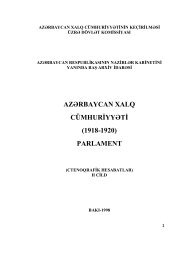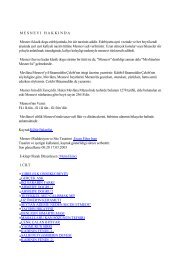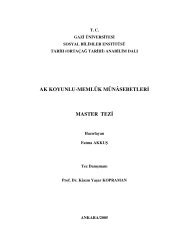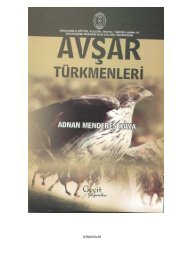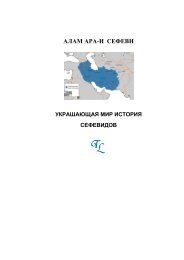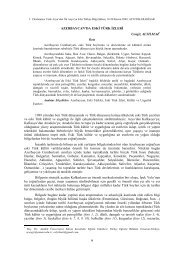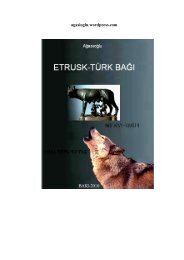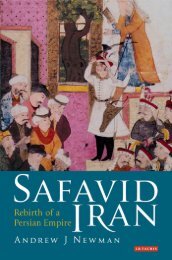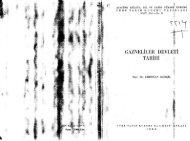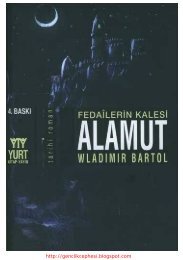War and Peace in Qajar Persia: Implications Past and ... - Oguzlar.az
War and Peace in Qajar Persia: Implications Past and ... - Oguzlar.az
War and Peace in Qajar Persia: Implications Past and ... - Oguzlar.az
- No tags were found...
You also want an ePaper? Increase the reach of your titles
YUMPU automatically turns print PDFs into web optimized ePapers that Google loves.
7 Crime, security, <strong>and</strong> <strong>in</strong>securitySocio-political conditions ofIran, 1875–1924Mansoureh Ettehadieh (Nezam-Mafie)<strong>Qajar</strong> Iran has often been depicted as a despotic country with little <strong>in</strong> theform of a st<strong>and</strong><strong>in</strong>g army or a bureaucracy. The weak central governmentoften relied on a balanc<strong>in</strong>g act of rewards <strong>and</strong> punishments to ma<strong>in</strong>ta<strong>in</strong> itscontrol. Nowhere was the weakness of the central government manifestedmore clearly than <strong>in</strong> the general state of lawlessness that existed <strong>in</strong> thecountryside <strong>and</strong> sometimes <strong>in</strong> the towns <strong>and</strong> cities as well. There are numerousaccounts of crim<strong>in</strong>als prey<strong>in</strong>g on civilians <strong>in</strong> memoirs <strong>and</strong> traveloguesfrom the period. There are also lurid accounts of the extraord<strong>in</strong>ary punishmentsthat were meted out to crim<strong>in</strong>als <strong>in</strong> these books, <strong>and</strong> yet we knowvery little beyond the general supposition that the country suffered fromlawlessness <strong>and</strong> crim<strong>in</strong>al activity on a scale little different than other countriesof the region <strong>and</strong> period, despite the very low figures suggested by the<strong>in</strong>telligence reports discussed below, which, <strong>in</strong> the prov<strong>in</strong>ce of Fars, put the<strong>in</strong>cidence of theft at less than six a year <strong>and</strong> robbery (or b<strong>and</strong>itry) at tena year.It is beyond the scope of this chapter to offer an overall view of crime <strong>and</strong>crim<strong>in</strong>al activity <strong>in</strong> the late <strong>Qajar</strong> period. Therefore, it is limited to the questionof theft <strong>and</strong> b<strong>and</strong>itry <strong>and</strong> their punishment as revealed <strong>in</strong> <strong>in</strong>telligencereports, as well as official <strong>and</strong> non-official newspaper accounts.DEFINING CRIMEIn general crime is a reflection of the life pattern <strong>and</strong> environment of thecrim<strong>in</strong>al <strong>and</strong> is a sign of social distress. Different crimes reflect the variousstructures of the community <strong>and</strong> the nature of social relations. For the purposeof this study, I divide crim<strong>in</strong>ality <strong>in</strong>to two broad categories, crime aga<strong>in</strong>stpersons <strong>and</strong> crime aga<strong>in</strong>st property. Crimes aga<strong>in</strong>st persons reveal specificforms of social tension. Crimes aga<strong>in</strong>st property reveal certa<strong>in</strong> types of economiccircumstances <strong>and</strong> conflicts. 1 This chapter specifically addresses thelatter category, namely crimes aga<strong>in</strong>st property.Accord<strong>in</strong>g to our criterion, theft occurred <strong>in</strong> urban areas, b<strong>and</strong>itry <strong>in</strong> theopen country. Theft was committed by one, two or a group of several thieves,



